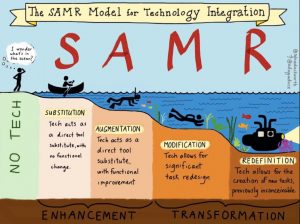I think my definition of technology would connect most closely to Muffoletto (1994) and the idea that technologies are a way of acting. Connecting to the definition of technology that started for me in ETEC 540 and that at a certain point in time a pencil was the current form of technology. The pencil allowed stories and ideas to be recorded. So what is an educational technology tool today may not be the most influential tomorrow but, just at the printing press allowed the spread of information through print, today’s technology is the act of creating and disseminating information and ideas in a faster way.
Keeping that definition in mind, I find myself returning to the visual below when I think of a TELE in my classroom. I think this graphic shows how as our understanding grows we get ready to take the next step and create more authentic use of educational technology in the classroom. Any time I prepare to bring in a technology I ask myself “can I do this with a pencil and paper?” if my answer is yes then I know I am at substitution. While there is a time and place for enhancing learning through technology I think the real value of technology appears when our lessons get into the transformation phase of SAMR.

References:
All Things SAMR Model by Blanca Lemus. (2016). Thinglink.com. Retrieved 29 May 2016, from https://www.thinglink.com/scene/661408904193769474
Muffoletto, R. (1994). Technology and restructuring education: Constructing a context. Educational Technology, 34(2), 24-28.
Hello Sarah,
This is a great visual, thanks for that. I’ve not taken ETEC 540, but I like the simple questioning test of “can I do this without technology?” as a test of enhancement vs. transformation. Not as a way to avoid technology (e.g. typing instead of writing) but to recognize that it may not be the limits of what is available in the classroom (using spreadsheets to handle thousands of data points, iPad and iMovie to make a video tutorial, timelapse features to record chemical reactions).
Mike
I am glad you like the visual, for me it provides an easy framework to start thinking about technology in my room. Sometimes doing the same job is good, we just need to recognize that is what we are doing. I love the idea of timelapse video for chemical reactions, that sure would have made first year chemistry a lot easier! Sarah
Hi Sarah,
I agree, that visual is extremely useful. I was also drawn to Muffoletto’s position that technology is a way of acting, and I feel that our students should be provided with learning opportunities (as you’ve described) that allow them to understand the impact of technology beyond merely “how to use” the tools. In terms of asking yourself the pencil question to determine whether or not you’re at the substitution level, I think that this would also be a valuable question to ask of our students and have them reflect on the technology goals and choices that they make for their own learning.
– Allen.
I often doubt my students ability to make these reflections, they are only 9 or 10 but I think you are right Allen, they may be more natural at it than I. I recently had the students do a write for me and gave them all computers to do it. One student asked me if they could write it by hand as they found it easier. I was surprised but they really are capable of making their own choices. Great point.
I like the fact that you brought your experiences from other MET classes.
I wonder what technology permitted the advent of distributed learning?
A good next step might be to consider what technology teachers will be using in 10, 50 or 100 years from now.
Christopher
That is an interesting question. It feels a lot like the question whether the printing press or the pencil allowed for the spread of knowledge. Certainly the ability for people to have a computer in their homes at reasonable cost was essential but so was the creation on the web. Distributed learning through e-mail just wouldn’t have the same popularity as on-line learning currently has.
I attended a conference almost two years ago and the speaker talked about where technology is going and how we haven’t seen anything yet. He talked of be able to touch the sleeve of a shirt to text and the ideas that seemed so far feteched in episodes of Star Trek are coming a little closer to reality. I have to say, if the MET program has encouraged me to think about anything, it is that it is not to worry about the tech we will be using in 10, 50 years, but establishing ways to evaluate tech and successful ways to support the integration of tech is far more important.
Hi Sarah,
In the evolution of technology in the classroom, do you think we need the initial idea of substitution in order to consider the rest of the SAMR to take place. It is of course easy to jump to Redefinition if you have seen it before, I am wondering if you think the first TELE was a basic Substitution which through subsequent iterations has allowed us to use the rest of the SAMR model?
I only ask because I like to consider the mind frame of such pioneers…